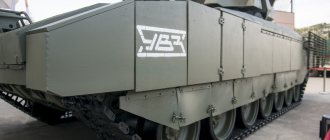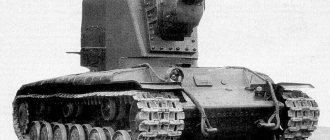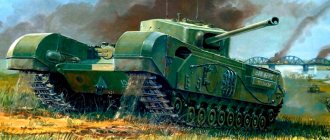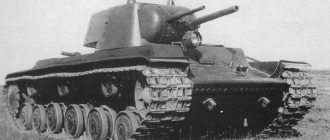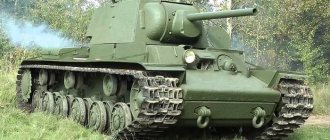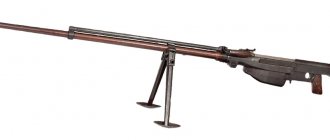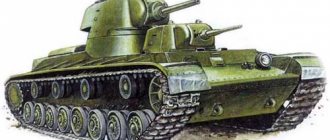T-10 (IS-8) is a heavy Soviet Tier IX tank with good mobility and a gun. On the way to Object 277 you will need to master this unit perfectly. Considering the regular additions to the branches, a lot of skill will be required to fully implement this tank. After all, if previous vehicles offered relatively good armor and allowed tanking, in this case the player will have to thoroughly study the features of the “pike nose”, gun, as well as all the possibilities in terms of maneuvers during the battle.
Historical reference
In 1948, GBTU issued technical specifications for the development of a new heavy tank. It was decided to use developments on the IS-3, and, in essence, the T-10 was its deep modernization. The main requirements were for weight - it should not exceed 50 tons. The first factory tests were carried out already in 1949, and in 1950 state tests were successfully completed, according to the results of which the IS-8 was adopted for service and mass production began. After Stalin's death, the name of the tank was changed to T-10. Production of the T-10 was discontinued in 1966, during which time the factories managed to produce more than 8,000 copies of various modifications. Thanks to its combination of characteristics: dimensions, armament, mobility, crew comfort, the T-10 was one of the most powerful tanks of its time. It became one of the main reasons for the start of “tank fever” in the USA and Great Britain.
Best in class (Soviet heavy tank T-10M)
The basis of modern armored military equipment is, as we know, tanks. Experts quite rightly call them the main striking force of the ground forces. They successfully combine great firepower, reliable armor protection and high maneuverability.
Soviet designers achieved the optimal combination of these qualities by creating the T-10M heavy tank, which is recognized as the best in its class.
Its firepower is provided by the installation of a 122 mm cannon and two heavy machine guns. The tasks in battle are determined according to the weapons. The range of a direct shot of a cannon at a target height of 2 m is 1130 m. At the entire distance, the trajectory of the projectile will not go beyond the specified dimensions; it seems to spread over the surface of the earth, retaining enormous kinetic energy, and consequently, impact force.
Two types of ammunition are used for firing: armor-piercing tracer shells weighing 25.1 kg and high-explosive fragmentation grenades weighing 27.3 kg. Correspondingly, the weight characteristics of artillery shots (shell-case): in the first case 45.96 kg, in the second - 47.76 kg. As you can see, the shots are quite impressive, which forced the designers to abandon unitary cartridges weighing almost half a centner each and introduce separate loading. In the latter case, the loader acts in two steps: first, he takes a projectile from one ammunition rack and sends it into the charging chamber of the barrel, and from the second ammunition rack he takes out a cartridge case and sends it after the projectile. The bolt closes automatically - the gun is ready to fire.
It must be said that the designers did, perhaps, the maximum possible to facilitate the loader’s actions. It is helped to deliver the projectile and cartridge case by the loading mechanism - an electrically driven carriage moving on skids. The loader's task is to place the projectile or cartridge case on the carriage tray. Automation will do the rest. The combat rate of fire reaches 3-4 aimed shots per minute.
The tank gun is equipped with two sights: one day, periscope provides a maximum sighting range of 4000 m; the second is infrared, allowing targeted shooting at night with a maximum target range of 1150 m.
The design of a tank gun is basically the same as that of a conventional field gun: a long barrel, a muzzle brake, a bolt, a cradle with recoil devices, guidance mechanisms, and a guard with a trigger mechanism. Although there are still a few distinctive features. After all, the internal volume of the tank’s fighting compartment is limited, and therefore the design requirements for the dimensions and weight of the gun’s components and parts, and their strength, are strict. Particular concern is ensuring high shooting accuracy. The reason is compelling: the ammunition is limited, each shot must be aimed, each fired projectile must reach the target.
To conduct effective fire while moving, the gun is equipped with a horizontal and vertical aiming stabilization system: neither turns nor uneven paths will disrupt the accuracy of the sight. The gunner only needs to point the aiming mark at the object, and the system instantly remembers this position and automatically points the gun barrel at it and holds it in the given direction. Thanks to this, the T-10M can fire on the move and hit a target with almost the same accuracy as from a standing position.
Now about machine guns. Both of them are the same, brand KPVT (Vladimirov heavy machine gun, tank), which is one of the most powerful large-caliber: each of its cartridges is 200 g, of which 64 g per bullet. This, in essence, is already a small projectile, which, moreover, it accelerates in the barrel bore to a very high initial speed—945 m/s.
One coaxial machine gun is installed parallel to the gun and is rigidly connected to it. It fires at ground targets: firing points and lightly armored vehicles. The longest sighting range is 2000 m. The gunner shoots, and the machine gun is loaded and cocked by the loader.
Another anti-aircraft machine gun is placed on the tank turret directly on the loader's hatch chase. The longest sighting range is 1000 m. If necessary, fire can also be opened on ground targets. The loader fires while standing on the seat.
A few words about the ammunition. Special ammunition packs contain 30 cannon rounds, 744 rounds of machine gun ammunition, 600 rounds of Kalashnikov assault rifle rounds, 20 hand grenades and 24 rounds of signal pistol rounds.
The general layout of the T-10M tank is made according to the classical design. Main parts: armored hull, turret, weapons, weapons stabilizer, power plant, power transmission, electrical equipment, communications, fire fighting equipment. There are three compartments inside: control, combat, power. Tank weight - 50 tons.
The armored hull and turret are the basis for protecting the equipment and crew, which consists of the commander, driver, gunner and loader. The housing unites all mechanisms and assemblies into a whole. He also absorbs all the loads that arise when moving, overcoming obstacles and firing.
The next most important indicator of a tank’s combat qualities is maneuverability. Despite its rather significant mass, the T-10M heavy tank has good mobility, agility and maneuverability.
The first of these qualities is the ability to cover long distances in a short time and, most importantly, to quickly attack the enemy. The main indicators of mobility are average speed and range. The heavy armored vehicle is capable of driving in off-road conditions and reaching speeds of 35-40 km/h on the highway. The maximum speed is 50 km/h. It is difficult to overestimate the importance of such an indicator as the power reserve, that is, the range of the tank on one fuel fill. Here a lot depends on the condition of the road: on a dirt road up to 200 km, on a concrete highway 350 km.
The term “agility” implies a turning radius, which for a tank, a typically tracked vehicle, is the smallest: experts consider it equal to the track width (the distance between the centers of the tracks is 2660 mm). So a heavy combat vehicle can literally turn around “on its heels.”
Finally, the third component of maneuverability is cross-country capability, that is, the tank’s ability to move off-road and overcome obstacles. There are extreme digital limitations here that the crew must keep firmly in mind. For example, the maximum elevation angle cannot exceed 32°, and the permissible limit is 30°. These sustainability indicators are considered good.
Other characteristics that determine the tank’s ability to overcome obstacles are also quite high. In particular, even a ditch 3 m wide and a vertical wall up to 0.9 m high will not hinder progress. The tank is also capable of overcoming water obstacles - along the bottom, as long as the ford depth does not exceed 1.5 m.
Of course, the T-10M is not immune to being hit by a shell or anti-tank missile. This may cause a fire. An automatic fire-fighting system is designed to combat it, consisting of thermoelectric switches and spray fittings, which are connected to cylinders with carbon dioxide. When the thermoelectric contactor heats up, its membrane bends and presses a microbutton - the electrical circuit is closed, the cylinder squib is triggered: its membrane breaks through, carbon dioxide flows through the pipelines to the source of the fire. It comes out of the spray nozzles in the form of gas and snow. The flame gets knocked down and goes out.
For camouflage purposes, the tank can put up a smoke screen. To ignite and release two large smoke bombs mounted on its stern, just press the buttons on the panel in the control compartment.
| BASIC DATA OF SOME POST-WAR | ||||
| HEAVY TANKS | ||||
| AMX-50A, | M103, | FV214 | T-10M | |
| France | USA | "Conqueror" England | USSR | |
| Year of issue | 1951 | 1953 | 1956 | 1957 |
| Crew, people | 4 | 5 | 4 | 4 |
| Combat weight, t | 50 | 62 | 66 | 50 |
| Length with gun | ||||
| forward (along the body), m | — (approx. 7.4) | 11,3 (6,98) | 11,58 (7,72) | 10,56 (7,25) |
| Width, m | OK. 3.4 | 3,76 | 3,99 | 3,38 |
| Height, m | OK. 2.9 | 2,88 | 3,35 | 2,58 |
| Speed max., km/h | 50 | 37 | 34 | 50 |
| Cruising range, km | — | 129 | 153 | 350 |
| engine's type | carburetor | carburetor | carburetor | diesel |
| Power | ||||
| engine, l. With. | 850 | 810 | 810 | 750 |
| Armament | ||||
| (quantity - | ||||
| caliber, mm): | ||||
| a gun | 1-100 | 1-120 | 1-120 | 1-122 |
| machine guns | 3-7,5 | 1-12,7 | 2-7,62 | 2-14,5 |
| 1-7,62 | ||||
| Armor thickness, | ||||
| max., mm | 120 | 178 | 200 | 200 |
| Quantity released | ||||
| new machines, pcs. | prototypes | 200 | 180 | — |
A. ALESHIN, V. SERGEEV Modeler - Designer. №2'1990
Video reviews
T-10 – HOW TO PLAY AND WHAT TO DO WITHOUT WoT GOLD? Hyde
T-10 – It doesn’t get any better!!!
“HARD BENDER...8000 DAMAGE on T-10” / WHAT IS THE T-10 CAPABLE OF? #The best for you
Modules:
Turrets/guns
| Lv. | Tower | Armor (mm) | Rotation (deg/sec) | Review (m) | Weight, kg) | Price (credits) |
| VIII | T-10 | 201/129/90 | 26 | 380 | 11 000 | 33 680 |
Compatible weapons:
| Lv. | gun | Penetration (mm) | Damage (HP) | Rapid fire (rounds/min) | Spread (m/100m) | Mixing (c) | BC | Weight, kg) | Price (credits) |
| VIII | 122 mm D-25T | 175/217/61 | 390/390/530 | 5.08 | 0.46 | 3.4 | 30 | 2 590 | 125 140 |
| IX | 122 mm BL-9 | 225/265/68 | 390/390/530 | 4.72 | 0.4 | 3.4 | 30 | 2 790 | 178 500 |
| X | 122 mm M62-T2 | 258/340/68 | 440/440/530 | 4.72 | 0.38 | 3.2 | 30 | 3 397 | 335 000 |
| Lv. | Tower | Armor (mm) | Rotation (deg/sec) | Review (m) | Weight, kg) | Price (credits) |
| IX | T-10M | 250/201/90 | 26 | 400 | 11 000 | 66 500 |
Compatible weapons:
| Lv. | gun | Penetration (mm) | Damage (HP) | Rapid fire (rounds/min) | Spread (m/100m) | Mixing (c) | BC | Weight, kg) | Price (credits) |
| VIII | 122 mm D-25T | 175/217/61 | 390/390/530 | 5.31 | 0.46 | 2.9 | 30 | 2 590 | 125 140 |
| IX | 122 mm BL-9 | 225/265/68 | 390/390/530 | 4.88 | 0.4 | 2.9 | 30 | 2 790 | 178 500 |
| X | 122 mm M62-T2 | 258/340/68 | 440/440/530 | 4.88 | 0.38 | 2.8 | 30 | 3 397 | 335 000 |
Engines
| Lv. | Engine | Power (hp) | Fire probability (%) | Weight, kg) | Price (credits) |
| IX | V-12-5 | 700 | 15 | 1 024 | 84 000 |
| IX | V-12-6 | 750 | 15 | 1024 | 84 200 |
Chassis
| Lv. | Chassis | Max. load (t) | Turning speed (gr/sec) | Rmin | Weight, kg) | Price (credits) |
| VIII | T-10 | 50.91 | 30 | B/2 | 10 000 | 27 920 |
| IX | T-10M | 58.9 | 32 | B/2 | 10 000 | 66 500 |
Radio stations
| Lv. | Radio station | Communication range (m) | Weight, kg) | Price (credits) |
| VII | 10RK | 440 | 100 | 18 600 |
| IX | 12RT | 625 | 110 | 33 600 |
| X | R-113 | 730 | 80 | 52 200 |
Order of studying modules:
| Chassis | Tower | gun | gun | Engine | Radio station | Radio station | |
| Result: Experience: 196050 Credits: 816050 | |||||||
| T-10M | T-10M | 122 mm BL-9 | 122 mm M62-T2 | V-12-6 | 12RT | R-113 | |
| 23800 experience - 66500 credits | 28300 experience - 66500 credits | 44,000 experience - 178,500 credits | 59300 experience - 335000 credits | 26350 experience - 84200 credits | 5600 experience - 33600 credits | 8700 experience - 52200 credits |
More details on the research.
- The T-10M chassis will add carrying capacity and also increase the maneuverability of the tank.
- T-10M turret - increases armor and viewing range.
- 122 mm BL-9 gun - provides access to the top gun.
- The 122 mm M62-T2 gun has high single-shot damage and excellent penetration.
- The V-12-6 engine significantly increases dynamics.
- Radio stations 12RT and R-113 - increase communication range.
More detailed information about the technique:
The T-10 battle tank is a development of the IS-3 combat unit, which is why it received all the advantages and disadvantages from it. The 122 mm M62-T2 gun has high single-shot damage and excellent penetration, but poor accuracy and long aiming times allow it to be used only at close and medium ranges. The hull armor is only 120 mm, but it is located at an angle, which sometimes allows for ricochet and non-penetration. The turret has much better armor, but it has many vulnerable areas - turrets, sights and surveillance devices. Also, poor vertical aiming angles do not allow you to play from the tower. Excellent running performance allows you to play in the ST style, but the long hull makes it an easy target for artillery and groups of enemy STs.
As a result: Most players consider the T-10 tank weaker than its predecessor, maybe they are right!!! Therefore, this tank requires a different style of play, you must not expose yourself to enemy shots and never ride on the enemy first. High speed allows you to be the first to take advantageous positions and ambush.


